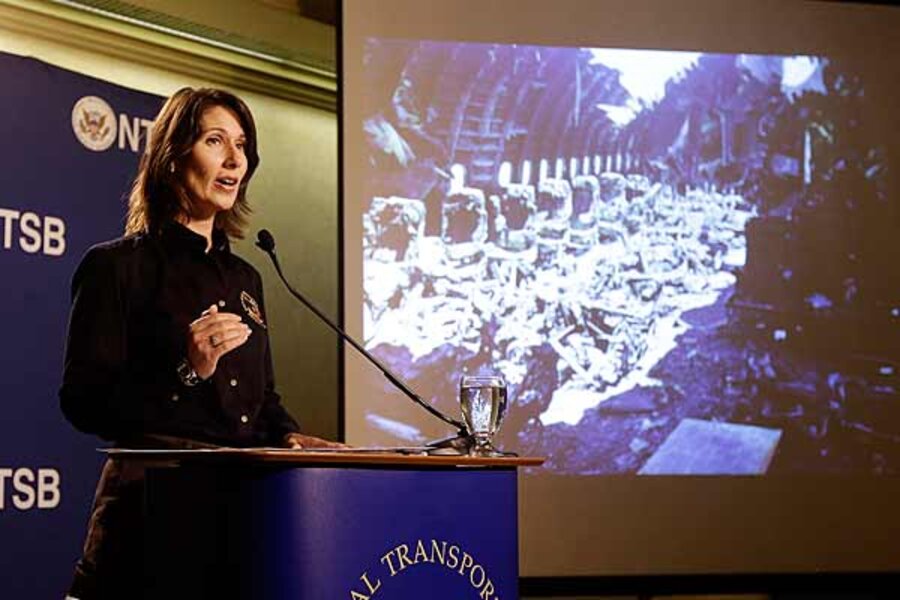Asiana Flight 214: Was the pilot training program to blame?
Loading...
| Seoul, South Korea
US aviation experts with experience training South Korean pilots are dismissing allegations that poor pilot training could have caused the crash of Asiana Airlines Flight 214 at San Francisco International Airport.
The crash landing on July 6 killed two people and injured more than 180 others. A US National Transportation Safety Board investigation is focusing on pilot Lee Gang-kuk, who was landing the Boeing 777 for the first time at that airport. They are also looking at his trainer Lee Jeong-min; the pilot was apparently his first trainee. Some have raised questions about whether Asiana's pilot training program is to blame.
Aviation experts, however, dismiss that question.
“Pilots who fly internationally are all trained to the same standards, set by the International Civil Aviation Organization (ICAO), and they have to abide by those, so there shouldn't be a lot of variation as to how pilots are trained from country to country,” says Dave Card, chief flight instructor and assistant professor at the University of Central Missouri’s department of aviation.
Moments before the plane’s tail crashed into the seawall just ahead of the airport, the pilots indicated they were having to adjust their path and altitude.
Though authorities have not identified a cause or placed blame on any one thing, it appears the pilots' efforts in those last few minutes were too little, too late. The plane was traveling abnormally slow in its final approach and fell short of the runway.
Soon after the accident, Asiana announced plans to intensify its training program.
As questions about Asiana’s training program started to surface, an e-mail written by someone named Tom Brown, claiming to be a former flight simulator instructor who trained Asiana pilots, began circulating online in aviation forums. The e-mail starts out:
After I retired from UAL as a Standards Captain on the – 400, I got a job as a simulator instructor working for Alteon (a Boeing subsidiary) at Asiana. When I first got there, I was shocked and surprised by the lack of basic piloting skills shown by most of the pilots...
Mr. Brown said that South Korean carriers’ poor international safety records had led their employers to bring in foreign pilots to train them. Brown’s message describes a “lack of basic piloting skills” among the South Korean pilots he trained, and says that the foreign instructors were “forced upon [the South Korean carriers] after the amount [sic] of fatal accidents” and faced “ingrained resistance from the Koreans.”
Asiana Airlines had no record of a Tom Brown working for the organization.
“I don’t know who he is, but I think that he chose to make these claims through an open e-mail says something about his character,” says Asiana spokeswoman Lee Hyo-min, who had been forwarded the e-mail. Asiana pilots are trained in full accordance with ICAO standards, she added.
Safety record
In its 2012 safety report, the ICAO said South Korea was above average in its implementation of safety oversight systems.
In the past, Korean airlines did have poor safety records. In the late 1990s, South Korea’s other main carrier Korean Air had a number of crashes, the most serious of which was a 1997 crash in Guam in which 228 people died.
After that crash, the airline was criticized for what some said was an overly hierarchical culture in the cockpit that made younger pilots reluctant to speak out about older colleagues' mistakes that put the flight at risk of crashing. Following the events of the late 1990s, Korean Air installed airline consultant David Greenberg, a retired Delta Air Lines vice president, to run the company. Mr. Greenberg set about stepping up Korean Air’s training and testing practices and introducing a more meritocratic company culture. The carrier has not had a crash since 1997.
In this case, as the younger pilot was at the controls under the instruction of the higher-ranking pilot, so, say experts, it’s unlikely that Korean cultural norms were the cause of the crash, as some early media reports speculated.
'What I can't understand'
Capt. Ross Aimer of Aero Consulting Experts provided training to South Korean pilots in the early 2000s, and says he encountered no questionable training practices within South Korean airlines.
“There’s nothing at all unusual about the way Korean pilots are trained compared to, say, pilots in the US,” says Captain Aimer, who worked in South Korea for Boeing and says the training he was involved in directly followed the same international standards observed elsewhere.
Aimer says it’s still too early to draw conclusions about why the plane went down, but says over reliance on automation could have played a role in the crash, a criticism also made in the memo by Brown.
Aimer says the pilots might not have monitored the plane’s speed due to an over-reliance on autopilot.
“I can’t understand why qualified and experienced pilots wouldn’t look at their speed for that long. That’s like you driving down the freeway and not looking out your front windshield for two full minutes,” Aimer said in a telephone interview.








